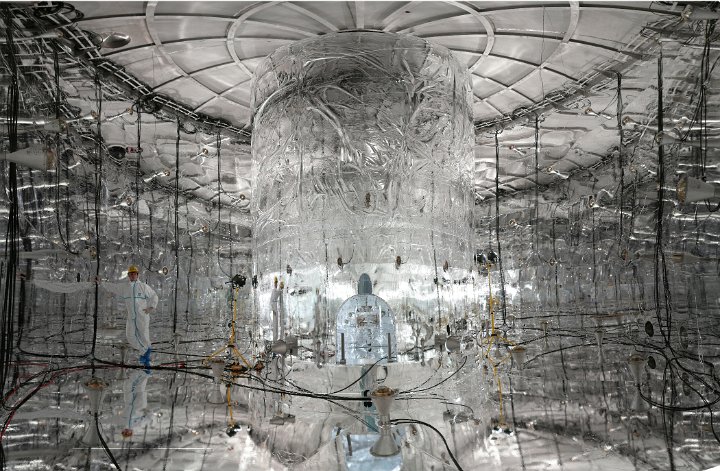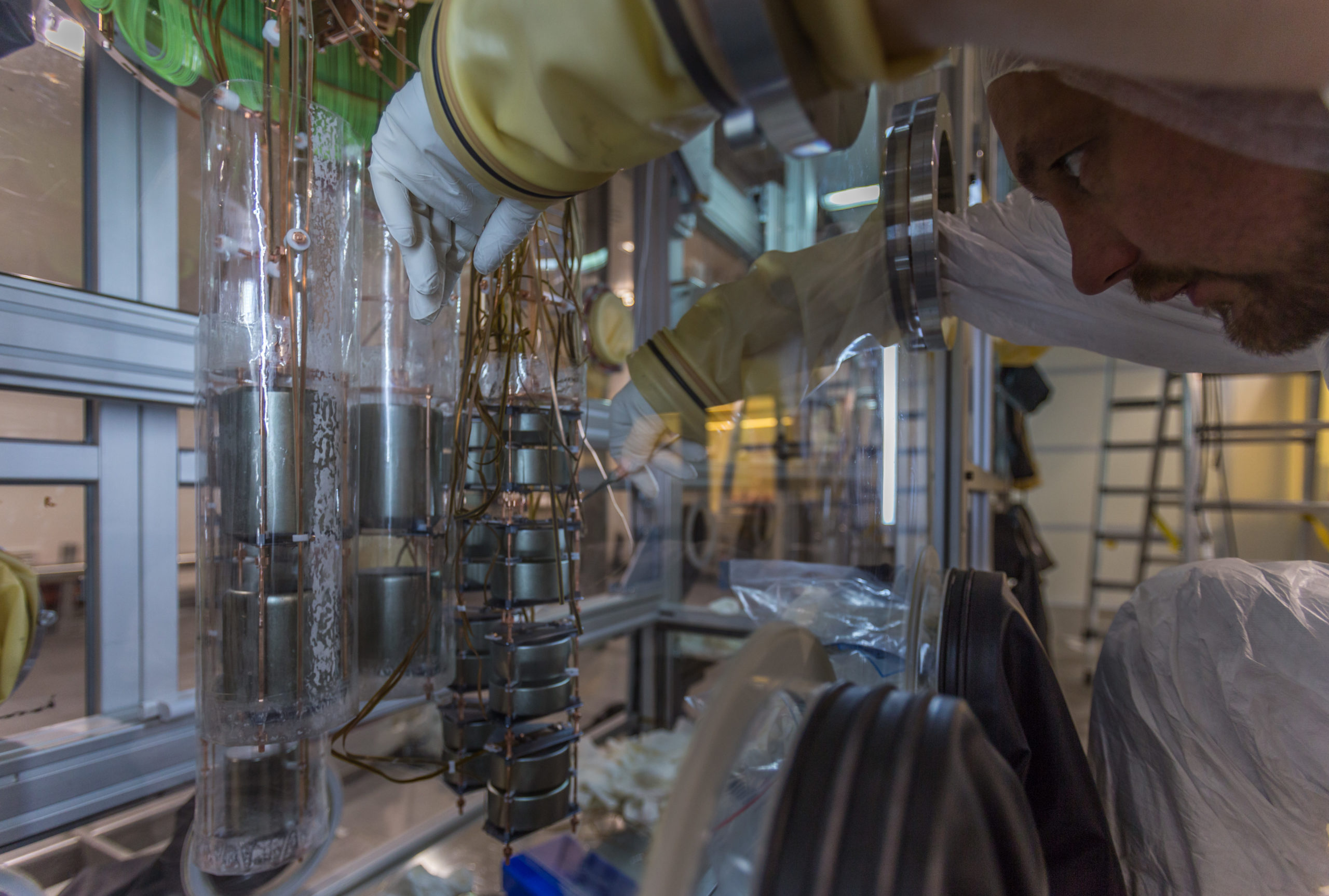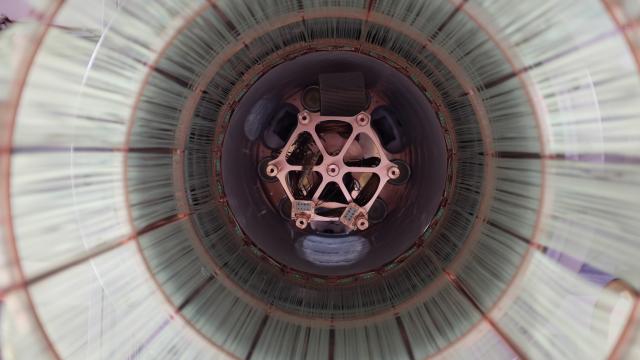You and me, we’re matter. Everyone you know is matter. Everything on Earth, spare a few particles, is matter. Most of the things in space are matter. But we don’t have convincing reasons why there should be so much more matter than antimatter. So where’s all the antimatter?
From Nature: “The fibre shroud of the liquid argon veto and the copper head for mounting the germanium strings. View from bottom.” Image: V. Wagner, GERDA collaboration
A team of European scientists have taken a major step in understanding this conundrum, using a house-sized detector called the Germanium Detector Array, or GERDA, buried inside a mountain in Grand Sasso, Italy. GERDA’s scientists are looking for a strange behaviour in radioactive atoms, called “neutrinoless double beta decay” (I’ll get to that in a second). Some versions of the rules of particle physics says this behaviour could help explain where all the antimatter went. But for now, the experiment is reporting some important results: It works.
“A discovery of [neutrinoless double beta] decay would have far-reaching consequences for our understanding of particle physics and cosmology,” the researchers write in the paper, published today in the journal Nature. It’s important that we understand why there is more matter than antimatter today. The Big Bang probably should have created equal amounts… but it didn’t.
If you have a good handle on what neutrinoless double beta decay is, you can skip the next three paragraphs. If not, it’s time for a break from our regular programming.
Matter is stuff, and it’s made of particles. Antimatter is also stuff, made from the particles’ antiparticle counterparts. We’ve made it in labs and some radioactive elements produce it. Every particle has an antiparticle, like electrons and positrons, which have the same mass, but opposite electric charge. If they meet, they annihilate each other in a burst of energy. There is not a lot of antimatter in the universe. Capisce?

From Nature: “The inner walls of the water tank are covered by a reflecting foil improving the light detection. This permits the identification of cosmic muons.” Image: K. Freund, GERDA collaboration
Neutrinos, they’re weird. Scientists don’t know how much they weigh, but even at the upper limit of what we guess their mass is, they’re many times lighter than electrons. They’re also really common — for example, the Sun is sending almost a hundred billion of them per square centimetre of your body every second. They don’t interact via electromagnetism, though, so they don’t harm us in any way. If they were their own antiparticle, what scientists call “Majorana particles”, they should annihilate one another. Most extensions of our main theory of particle physics, called the Standard Model, say this is true.
So, the key is to build an experiment that can test whether neutrinos are annihilating one another, and to look for a process that should usually create neutrinos, but doesn’t. In this case, that process is radioactive beta decay, where the neutral neutron turns into a positive proton, a negative electron, and an antineutrino. Some forms of some atoms, like germanium should go through double beta decay, where two neutrons decay simultaneously. If scientists observe double beta decay without any neutrinos (or antineutrinos), then they can say they have spotted this neutrinoless double beta decay. This would demonstrate that neutrinos and antineutrinos are essentially the same, and convince us that our physics theories can explain why there’s more matter than antimatter.

From Nature: “Working on the germanium detector array within the glove box which is located in the clean room on top of the liquid argon cryostat.” (Image: J. Suvorov, GERDA collaboration)
That’s what GERDA is looking for. They’re watching 35.6kg of a special form of germanium, the shiny semiconducting metal, sitting inside a vat of liquid argon inside a bigger vat of water, waiting however long it takes for it to experience a neutrinoless double beta decay. No, they haven’t found any evidence of the process yet. But their experiment works really, really well — there’s no background noise, which is an incredible feat. Otherwise, we might see a false signal. And there’s radiation that could set off the detector everywhere, from the Sun to the air we breathe.
“Imagine running a radiation detector for a year and seeing nothing! It’s quite an experience,” said Duke physicist Phillip Barbeau, who is not involved in the GERDA collaboration, in an interview with Gizmodo. “We need discerning detectors, ones that avoid sources of these backgrounds by going deep underground, avoiding dust, building them in clean rooms, avoiding cosmic activation of these materials. After all, they can turn radioactive simply by being above ground.”
Scientists are at least sure that the experiment is working, and not just turned off, by the way. “People would give them the benefit of the doubt,” said Barbeau. But “it’s a difficult experiment to run because you see nothing in the detector”.
But there are plenty of other complicating factors in this process aside from getting rid of all the outside noise. Most processes we’ve observed in the universe conserves a property called lepton number. In theory, the number of leptons (neutrinos and electrons are examples of leptons) minus the number of antileptons should remain the same before and after some physical reaction. Regular beta decay starts with a lepton number of zero and ends with zero (one electron minus one antineutrino). Neutrinoless double beta decay starts with zero and ends with two. As a note, we want to see this violation happen. I’m just pointing out that this decay is breaking a not-that-well-supported rule.
And the neutrinoless double beta decay is really, really rare — its half life, the amount of time it takes for half of the possible events to happen, is several times the age of the universe. So scientists might have to sit and watch this vat for a very, very long time. But hey, that’s why they have so much germanium.
GERDA isn’t the only experiment looking for this decay — there’s the MAJORANA experiment, the CUORE-0 and COBRA. If we don’t spot this decay, we might just have to go looking for other evidence of neutrinos being their own antiparticles. And there’s so much more about neutrinos we don’t know — we can’t even accurately measure their mass, for example.
Anyway, now that we have the working GERDA detector… it’s time to watch and wait.
[Nature]
